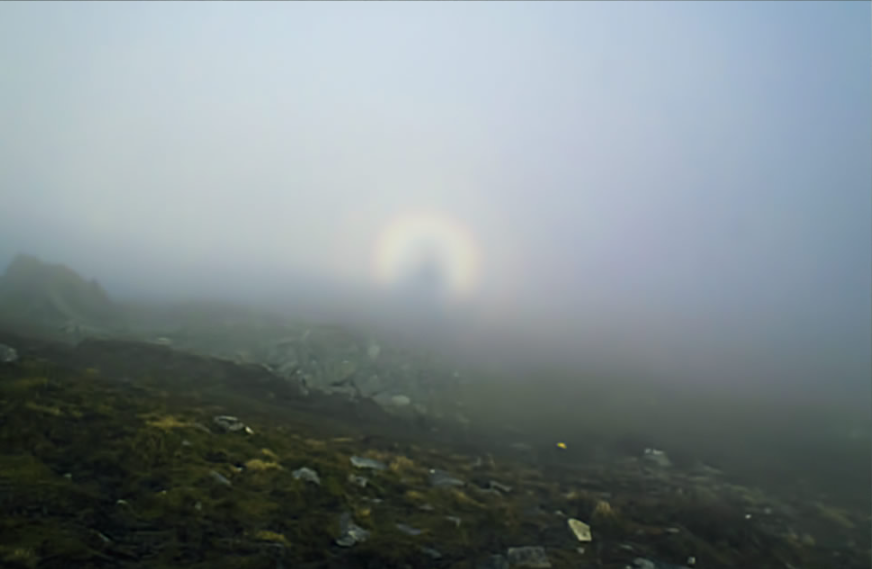OPOD - Brocken Spectre
OPOD - Brocken Spectre: A Ghostly Optical Phenomenon Unveiled
The Brocken Spectre, a ghostly apparition, has mystified and captivated climbers for centuries. One such encounter was experienced by Peter O'Toole on the summit of Slieve League in South Donegal, Ireland. The Brocken, standing at 1141m, is the highest peak in Germany's Harz Mountains. Despite its relatively modest height, the conditions on the Brocken are remarkably extreme, resembling those found on much taller peaks. With an average temperature of only 2.9 degrees Celsius and a persistent mist that envelops it for up to 300 days each year, the mountain provides a perfect setting for this ethereal phenomenon.
Early climbers ascending the Brocken would often witness a colossal figure emerging from the mist, giving rise to the legend of the "Spectre of the Brocken." This ghostly apparition appeared immense, with its head sometimes adorned with an otherworldly glow and even colored rings. The misty landscape, devoid of reference points, contributed to the perception of its immense size.
The Brocken Spectre is actually a combination of two optical effects—one elementary and the other more complex in nature. The gigantic figure observed is the shadow of the viewer projected through the mist when sunlight breaks through. Due to the lack of visual cues in the misty environment, the shadow may appear disproportionately large, intensifying the awe-inspiring experience.
Accompanying the Spectre's head is a phenomenon known as a glory. This optical effect involves small water droplets within the mist diffracting sunlight and scattering it almost directly backward. The result is a captivating glow that surrounds the Spectre's head, occasionally accompanied by rings of color. While modern technology can now simulate a glory on a laptop within seconds, comprehending the intricate physical mechanisms responsible for this scattering phenomenon remains a challenge.
The Brocken Spectre continues to enchant mountaineers and scientists alike, prompting further exploration and study of this mesmerizing atmospheric phenomenon. By unraveling the mysteries surrounding this optical spectacle, researchers hope to gain a deeper understanding of the intricate interplay between light, mist, and perception.
It is worth noting that this article has been automatically converted from the old site, and as a result, the formatting may not appear as intended. For the original article, please refer to the link provided at the end.
In conclusion, the Brocken Spectre serves as a reminder of the captivating wonders that can be found within our natural world. Its ethereal presence, born from misty mountain peaks, has fascinated generations of climbers and inspired scientific inquiry. As we continue to explore and unravel the complexities of atmospheric optics, phenomena like the Brocken Spectre remind us of the beauty and mystery that surround us, waiting to be discovered and understood.
Brocken Spectre
The ghostly apparition was encountered by Peter O'Toole on the summit of Slieve League, South Donegal, Ireland.
Images ©Peter O'Toole.

The Brocken is the highest peak of Germany's Harz Mountains. Although only 1141m high, conditions on it are more extreme and like those on much higher peaks. It has a mean temperature of only 2.9 celsius and is said to be mist shrouded for up to 300 days each year.
The mist causes the legend. Early climbers would see a ghostly and apparently huge figure loom out of the mist. Its head was sometimes wreathed in an ethereal glow and even coloured rings. The "Spectre of the Brocken" was born.

The Brocken Spectre is a combination of two optical effects, one elementary and the other very complicated indeed.
The huge figure is the observer's shadow projected through the mist as the sun breaks through. It sometimes appears huge because the misty landscape provides few references with which to judge size.
The glow and sometimes rings around the Spectre's head is a glory.
The small water droplets of the mist diffract sunlight and scatter it almost directly backwards to form the glow. Although the glory is now easily simulated in a matter of seconds by a laptop, the actual physical mechanism of the scattering is not easy to visualize or understand.

Note: this article has been automatically converted from the old site and may not appear as intended. You can find the original article here.
Reference Atmospheric Optics
If you use any of the definitions, information, or data presented on Atmospheric Optics, please copy the link or reference below to properly credit us as the reference source. Thank you!
-
<a href="https://atoptics.co.uk/blog/opod-brocken-spectre/">OPOD - Brocken Spectre</a>
-
"OPOD - Brocken Spectre". Atmospheric Optics. Accessed on December 23, 2024. https://atoptics.co.uk/blog/opod-brocken-spectre/.
-
"OPOD - Brocken Spectre". Atmospheric Optics, https://atoptics.co.uk/blog/opod-brocken-spectre/. Accessed 23 December, 2024
-
OPOD - Brocken Spectre. Atmospheric Optics. Retrieved from https://atoptics.co.uk/blog/opod-brocken-spectre/.